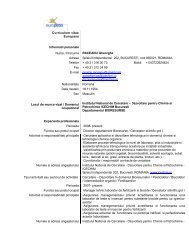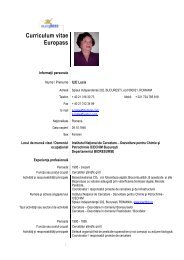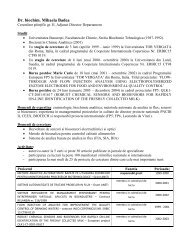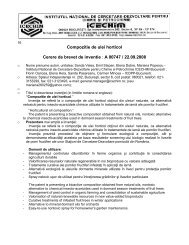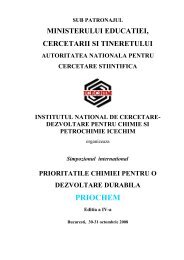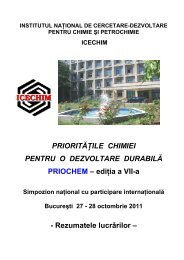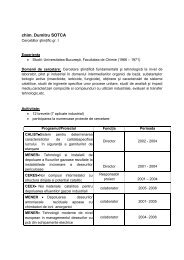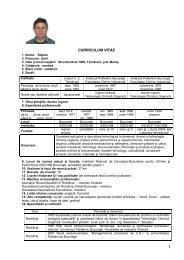INSTITUTUL NAÅ¢IONAL DE CERCETARE-DEZVOLTARE - ICECHIM
INSTITUTUL NAÅ¢IONAL DE CERCETARE-DEZVOLTARE - ICECHIM
INSTITUTUL NAÅ¢IONAL DE CERCETARE-DEZVOLTARE - ICECHIM
- No tags were found...
You also want an ePaper? Increase the reach of your titles
YUMPU automatically turns print PDFs into web optimized ePapers that Google loves.
1 Bioresources and biomaterials - PENZYMATIC COMPOSITES SYNTHESIZED BY COVALENT IMMOBILIZATIONON POLYMER MEMBRANEST. Sandu 1, 2 , A. Sârbu 2 , C. M. Damian 1 , H. Iovu 1[1] Universitatea Politehnica – Strada Polizu 1-7, Bucuresti[2] INCDCP-<strong>ICECHIM</strong>, Splaiul Independentei 202, BucurestiThe aim of the present study was to prepare enzymatic composites by covalentimmobilization on polymer membranes and to determine the optimal conditions for theenzyme immobilization. The enzyme was immobilized in order to enhance its pH and thermalstability.In order to meet these purposes two polymer membranes were prepared using anacrylonitrile-vinyl acetate copolymer (AN-AV, with a ratio of AN/ AV in the monomermixture of 2.35) and polyvinyl alcohol (APV). According to literature informationpolyacrylonitrile-based membranes are often used as supports for enzyme immobilization [1] .Both membranes, M1 and M2, were prepared from mixtures of the copolymer with differentcontents of APV, by the coagulation of the polymer solutions in a bath composed of a waterisopropanolmixture.Because membranes themselves are not able to covalently immobilize enzymes, thesemembranes were functionalized with glutardialdehyde. The functionalization leads to –CHOgroups insertion on membrane surface. These groups are further used for enzyme covalentimmobilization. Tyrosinase from mushrooms is the enzyme which was immobilized. Thisenzyme is also known as phenolase, phenol oxidase, polyphenol oxidase or o-diphenoloxidase, depending on its substrate specificity [2] .The functionalization and enzyme immobilization effect on the membranescomposition (FTIR) and thermal behavior (TGA and DSC) was extensively studied.Bibliography[1]F. Q. Nie, Z. K. Xu, P. Ye, J. Wu, P. Seta, Polymer 45, 2004, 399-407.[2]A. Mohammadi, A. B. Moghaddam, R. Dianravand, S. Razaei-Zarchi, Int. J. Electrochem. Sci. 4, 2009, 895-905.




